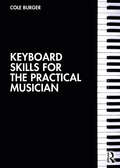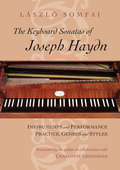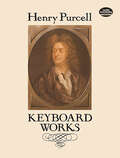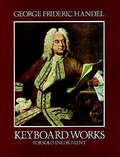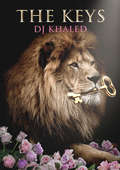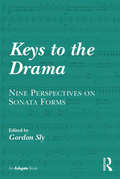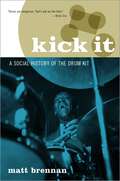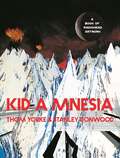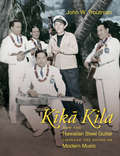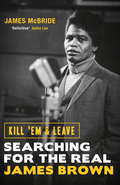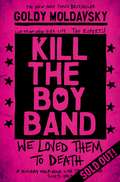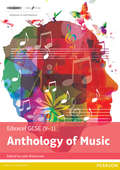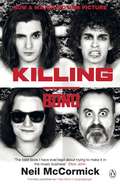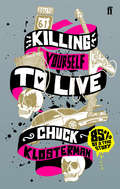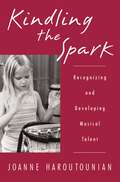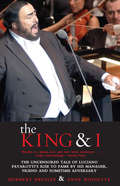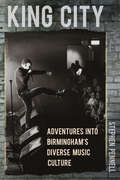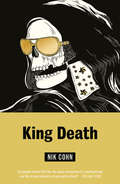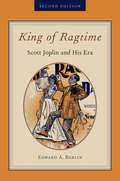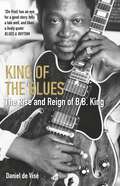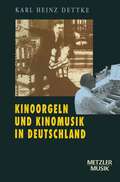- Table View
- List View
Keyboard Skills for the Practical Musician
by Cole BurgerKeyboard Skills for the Practical Musician provides undergraduate music majors in class piano courses with the techniques and fundamentals they need to flourish into independent, versatile musicians who play with confidence and sensitivity. Organized by skill (rather than level), the topics sequenced in this textbook offer endless flexibility for instructors while guiding students in a step-by-step approach through the development of essential keyboard skills ? such as reading, harmonization, improvisation, and accompaniment ? supporting concepts learned in music theory, ear training, private lessons, methods classes, and ensemble courses. One can draw from many sections of the book in any given class or semester, covering a wide range of piano skills that foster abilities frequently used in a myriad of musical professions.Features: • Over 400 sightreading, transposition, and score reading examples, along with 125 harmonization Melodies• Project assignments that promote independent learning, expose students to new musical styles, and encourage collaboration • A concluding Repertoire section with lists of solo and duet music, 10 ensemble arrangements, 6 duets, and additional pieces from the Baroque, Classical, Romantic, and Post-Romantic eras • Music examples include numerous works by composers from marginalized backgrounds and from global folk music• No prior piano background knowledge neededExplaining the core elements of keyboard learning in an accessible and responsive format while accentuating the importance of learning how to learn, Keyboard Skills for the Practical Musician offers an essential resource for all class piano students and instructors.
The Keyboard Sonatas of Joseph Haydn: Instruments and Performance Practice, Genres and Styles
by László SomfaiInterest in the authentic performance of early music has grown dramatically in recent years, and scholarly investigation has particularly benefited the study of keyboard music of the classical period. In this landmark publication, the most comprehensive study written on Haydn's keyboard sonatas, a leading Haydn scholar presents novel ideas, corrects misconceptions, and offers new hypotheses on long-debated issues of early music research. Laszlo Somfai begins with a thorough study of Haydn's keyboard instruments and their development. After recommending instruments appropriate for modern use, he discusses performance practice and style, explains the peculiarities of Haydn's manuscripts in the context of eighteenth-century notation, and provides specific suggestions for playing ornaments, improvising, slurring, and dynamics. He also investigates Haydn's sonata genres within their historical context and discusses the problems of establishing a chronology of their composition. Finally, Somfai analyzes the organization and style of each musical form. The book includes an index listing the sonatas by date of first publication, and an extensive bibliography.
Keyboard Works
by Henry PurcellRenowned for the originality of his music and his gifts as a melodist, Henry Purcell (1659-1695) was the preeminent English composer of the seventeenth century and one of the greatest that nation has ever produced. His gifts are apparent not only in the vocal and orchestral works on which his fame rests, but in his delightful keyboard music, much of which is relatively simple and easy to perform. This volume is a near-complete collection of Purcell's keyboard compositions, including the eight suites, the core of his keyboard works. Also included are many miscellaneous one-movement pieces: airs, trumpet tunes (for harpsichord solo), grounds, preludes, dances, etc.Piano students and pianists of intermediate skills will enjoy these pieces for their charm and accessibility. Gathered here in one convenient, inexpensive volume, they offer a treasury of time-honored music that musicians and music lovers will turn to again and again.This volume has been edited with a preface by the noted music scholar William Barclay Squire.
Keyboard Works for Solo Instrument
by George Frideric HandelThe music historian Sir John Hawkings recorded that his friend Handel's keyboard improvisations "stole on the ear in a slow and solemn progression; the harmony close wrought, and as full as could be possibly be expressed; the passage concatenated with stupendous art, the whole at the same time being perfectly intelligible, and carrying the appearance of great simplicity." Such fecund spontaneity generated the few published pieces Handel wrote specifically for the keyboard. The first set of suites appeared in 1720, perhaps composed and published for the instruction of Princess Anne, to whom Handel serves as music master. Other collections of harpsichord and clavichord work followed; all seem to have been preserved from Handel's freely inventive keyboard sessions. Here, for the first time in a popularly accessible edition, are 35 of his finest keyboard works for solo instruments, reproduced from the monumental Deutsche Händelgesellschaft edition, still the most complete.This collection features the celebrated Eight Great Suites, including the Harmonious Blacksmith Air and the Passacaille in G Minor (G 255), "a work in which Handel approaches most nearly to the monumental style of his choral writing" (Grove's Dictionary). Other works include: Fugue in A Minor; Fantasia in C Major; Suite (Partita) in G Minor; Sonatina in B-flat Major; Capriccio in F Major; Minuet in G Minor; Sonatas in C Major; Chaconne in F Major; Prelude and Sonata in G Minor; and more.For this new edition, the pieces have been rearranged and retitled according to the latest scholarly sequences found in The New Grove Dictionary of Music and Musicians. Students and scholars will find many of the ideas Handel sketched here expanded and reworked in later chamber and orchestral works and in the opera dance movements; musicians and every Baroque music lover will see in these neglected pieces "a Protean fluidity" (New Grove) worthy of the great composer, and more than worthy of any musical library.
The Keys: They Don't Want You To Read This Book
by Dj KhaledIn The Keys, Snapchat sensation and recording artist DJ Khaled guides you through the pathway to success. Within these pages, he shares the wisdom of his life lessons, such as:- Stay away from They- Don’t ever play yourself- Respect the code- Win, win win, no matter whatThis positive, motivational book will give you the advice you need to go out there and create the life you’ve always wanted. Its upbeat, inspirational message will show you that you can achieve great things if you keep focussed, stay positive and never listen to the doubters.
Keys to the Drama: Nine Perspectives on Sonata Forms
by Gordon SlySonata form is fundamentally a dramatic structure that creates, manipulates, and ultimately satisfies expectation. It engages its audience by inviting prediction, association, and interpretation. That sonata form was the chief vehicle of dramatic instrumental music for nearly 200 years is due to the power, the universality, and the tonal and stylistic adaptability of its conception. This book presents nine studies whose central focus is sonata form. Their diversity attests both to the manifold analytical approaches to which the form responds, and to the vast range of musical possibility within the form's exemplars. At the same time, common compositional issues, analytical methods, and overarching perspectives on the essential nature of the form weave their way through the volume. Several of the essays approach the musical structure directly as drama, casting the work as an expression of its composer's engagement with an idea or principle that is dynamic and at times intensely difficult. Others concentrate their attention on a composer's use of "motive," which typically takes the form of a simple melodic span that shapes the musical architecture through an interdependent series of structural levels. Integrating these motivic threads within the musical fabric often warrants departures from formal norms in other areas. Analyses that seek to understand works with anomalous formal qualities-whether engendered by a motivic component or not-have a prominent place in the volume. Among these, accounts of idiosyncratic tonal discourse that threatens to undermine the unfolding of form-defining qualities or events are central.
Keys to the Drama: Nine Perspectives on Sonata Forms
by Gordon SlySonata form is fundamentally a dramatic structure that creates, manipulates, and ultimately satisfies expectation. It engages its audience by inviting prediction, association, and interpretation. That sonata form was the chief vehicle of dramatic instrumental music for nearly 200 years is due to the power, the universality, and the tonal and stylistic adaptability of its conception. This book presents nine studies whose central focus is sonata form. Their diversity attests both to the manifold analytical approaches to which the form responds, and to the vast range of musical possibility within the form's exemplars. At the same time, common compositional issues, analytical methods, and overarching perspectives on the essential nature of the form weave their way through the volume. Several of the essays approach the musical structure directly as drama, casting the work as an expression of its composer's engagement with an idea or principle that is dynamic and at times intensely difficult. Others concentrate their attention on a composer's use of "motive," which typically takes the form of a simple melodic span that shapes the musical architecture through an interdependent series of structural levels. Integrating these motivic threads within the musical fabric often warrants departures from formal norms in other areas. Analyses that seek to understand works with anomalous formal qualities-whether engendered by a motivic component or not-have a prominent place in the volume. Among these, accounts of idiosyncratic tonal discourse that threatens to undermine the unfolding of form-defining qualities or events are central.
Kick It: A Social History of the Drum Kit
by Matt BrennanThe drum kit has provided the pulse of popular music from before the dawn of jazz up to the present day pop charts. Kick It, a provocative social history of the instrument, looks closely at key innovators in the development of the drum kit: inventors and manufacturers like the Ludwig and Zildjian dynasties, jazz icons like Gene Krupa and Max Roach, rock stars from Ringo Starr to Keith Moon, and popular artists who haven't always got their dues as drummers, such as Karen Carpenter and J Dilla. Tackling the history of race relations, global migration, and the changing tension between high and low culture, author Matt Brennan makes the case for the drum kit's role as one of the most transformative musical inventions of the modern era. Kick It shows how the drum kit and drummers helped change modern music--and society as a whole--from the bottom up.
Kick It: A Social History of the Drum Kit
by Matt BrennanThe drum kit has provided the pulse of popular music from before the dawn of jazz up to the present day pop charts. Kick It, a provocative social history of the instrument, looks closely at key innovators in the development of the drum kit: inventors and manufacturers like the Ludwig and Zildjian dynasties, jazz icons like Gene Krupa and Max Roach, rock stars from Ringo Starr to Keith Moon, and popular artists who haven't always got their dues as drummers, such as Karen Carpenter and J Dilla. Tackling the history of race relations, global migration, and the changing tension between high and low culture, author Matt Brennan makes the case for the drum kit's role as one of the most transformative musical inventions of the modern era. Kick It shows how the drum kit and drummers helped change modern music--and society as a whole--from the bottom up.
Kid A Mnesia: A Book of Radiohead Artwork
by Stanley Donwood Thom YorkeWhilst these records were being conceived, rehearsed, recorded and produced, Thom Yorke and Stanley Donwood made hundreds of images. These ranged from obsessive, insomniac scrawls in biro to six-foot-square painted canvases, from scissors-and-glue collages to immense digital landscapes. They utilised every medium they could find, from sticks and knives to the emerging digital technologies. The work chronicles their obsessions at the time: minotaurs, genocide, maps, globalisation, monsters, pylons, dams, volcanoes, locusts, lightning, helicopters, Hiroshima, show homes and ring roads. What emerges is a deeply strange portrait of the years at the commencement of this century. A time that seems an age ago - but so much remains the same.
Kika Kila: How the Hawaiian Steel Guitar Changed the Sound of Modern Music
by John W. TroutmanSince the nineteenth century, the distinct tones of k&299;k&257; kila, the Hawaiian steel guitar, have defined the island sound. Here historian and steel guitarist John W. Troutman offers the instrument's definitive history, from its discovery by a young Hawaiian royalist named Joseph Kekuku to its revolutionary influence on American and world music. During the early twentieth century, Hawaiian musicians traveled the globe, from tent shows in the Mississippi Delta, where they shaped the new sounds of country and the blues, to regal theaters and vaudeville stages in New York, Berlin, Kolkata, and beyond. In the process, Hawaiian guitarists recast the role of the guitar in modern life. But as Troutman explains, by the 1970s the instrument's embrace and adoption overseas also worked to challenge its cultural legitimacy in the eyes of a new generation of Hawaiian musicians. As a consequence, the indigenous instrument nearly disappeared in its homeland.Using rich musical and historical sources, including interviews with musicians and their descendants, Troutman provides the complete story of how this Native Hawaiian instrument transformed not only American music but the sounds of modern music throughout the world.
Kill 'Em and Leave: Searching for the Real James Brown
by James McBride'A formidable free-style book that isn't straight biography but a mix of history, street-level investigative reporting, hagiography, Deep South sociology, music criticism, memoir and some fiery preaching' Rolling Stone magazineA Guardian best music book of 2016The music of James Brown was almost a genre in its own right, and he was one of the biggest and most influential cultural figures of the twentieth century. But the singer known as the 'Hardest Working Man in Show Business' was also an immensely troubled, misunderstood and complicated man. Award-winning writer James McBride, himself a professional musician, has undertaken a journey of discovery in search of the 'real' James Brown, delving into the heartbreaking saga of Brown's childhood and destroyed estate, and uncovering the hidden history of Brown's early years.
Kill the Boy Band (Point Ser.)
by Goldy MoldavskyFangirls get a bad rap all the time - people say we're weird, hysterical, obsessed, certifiable. But those people don't understand. Just because we're fangirls, doesn't mean we're crazy. It's important you know that up front. Because everything I'm about to tell you is going to seem . . . well, crazy. From thrilling debut author Goldy Moldavsky comes Kill The Boy Band, a pitch-black, hilarious take on modern fandom and the badass girls who have the power to make - or break - the people we call 'celebrities'.
"Killer Queen" from "Sheer Heart Attack" (PDF)
by Freddie Mercury Saz Ed.This is a musical score in Modified Stave Notation. The original file is available as .mscz format and the braille music version as .brf from mas@rnib.org.uk
Killing Bono: I Was Bono's Doppelganger
by Neil McCormick'Squirm-inducing, excruciatingly honest and painfully funny' Joseph O'ConnorWe all went to school with friends who've turned out more successful than ourselves. But they don't all phone from improbably glamorous places and drive us mad by telling us about it. And they're not all Bono. Neil McCormick always dreamed of life as a rock star. Instead, he had to watch while his friend became one of the most famous men on the planet. Killing Bono tells the story of the less-than-successful rival band which he set up with his brother Ivan in the late 1970s. While the young brothers struggled to find success Bono and his friends went on to achieve superstar status. A heartwarming story of friendship, loyalty, rivalry and ambition, read it and weep - with sympathy and laughter.
Killing Yourself to Live: 85% of a True Story
by Chuck KlostermanFor 6,557 miles, from New York to Mississippi to Seattle, Chuck Klosterman decided to chase rock n roll and death across a continent. 21 days later, after three relationships, an encounter with various cottonmouth snakes, and a night spent snorting cocaine in a graveyard, Klosterman started to order his thoughts on American culture and the meaning of celebrity.
Kindling the Spark: Recognizing and Developing Musical Talent
by Joanne HaroutounianGathering perspectives of musical talent from the psychological, musical, and educational fields, Kindling the Spark is the only single sourcebook that defines musical talent and provides practical strategies for identifying and nurturing it. Joanne Haroutounian uses her experience as teacher, researcher, and parent to clarify central issues concerning talent recognition and development in a way that will easily appeal to a wide audience. The book describes the different stages of development in musical training, including guidelines for finding a suitable teacher at different levels, social and psychological aspects that impact musical training, and research on talent development by ages and stages from infancy and preschool years through the teen years. An important feature of the book are "sparkler exercises" designed to provoke observable talent behavior in home, school, and studio settings. The book also includes an Appendix of Resources which lists books, media, organizations, and specialized schools that offer additional information on musical talent, identification, and development. For music educators in both public school and private studio settings--as well as for parents and their musically inclined children--Kindling the Spark provides an invaluable summary of the research on talent and a wealth of resources for developing it.
Kindling the Spark: Recognizing and Developing Musical Talent
by Joanne HaroutounianGathering perspectives of musical talent from the psychological, musical, and educational fields, Kindling the Spark is the only single sourcebook that defines musical talent and provides practical strategies for identifying and nurturing it. Joanne Haroutounian uses her experience as teacher, researcher, and parent to clarify central issues concerning talent recognition and development in a way that will easily appeal to a wide audience. The book describes the different stages of development in musical training, including guidelines for finding a suitable teacher at different levels, social and psychological aspects that impact musical training, and research on talent development by ages and stages from infancy and preschool years through the teen years. An important feature of the book are "sparkler exercises" designed to provoke observable talent behavior in home, school, and studio settings. The book also includes an Appendix of Resources which lists books, media, organizations, and specialized schools that offer additional information on musical talent, identification, and development. For music educators in both public school and private studio settings--as well as for parents and their musically inclined children--Kindling the Spark provides an invaluable summary of the research on talent and a wealth of resources for developing it.
The King and I: The Uncensored Tale of Luciano Pavarotti's Rise to Fame by his Manager, Friend and Sometime Adversary
by Anne Midgette Herbert BreslinIn 1967, Luciano Pavarotti was an up-and-coming young tenor with a voice far more impressive than his stage technique or presence. So Decca, his record company, told him, 'Luciano, you're a real nice guy. So you need a real bastard to do your publicity.' Enter Herbert Breslin. The two of them hit it off and thus began a professional association and a friendship that lasted over 36 years.The King and I is the story of that relationship, during which Breslin guided what he calls, justifiably, 'the greatest career in classical music', moving Pavarotti out of the opera house and into the arms of the mass public. He and Pavarotti changed the landscape of opera and Breslin relates the story of their journey in a candid, witty fashion that is often hysterically frank and profane. His portrait of his friend and client is full of hilarious details that could only come from a true insider. The King and I is the ultimate backstage book about the greatest opera star of the past century - and the last word comes from none other than Luciano Pavarotti himself.
King City: Adventures into Birmingham's Diverse Music Culture
by Stephen PennellBirmingham has a tradition of individualism and experimentation, giving rise to a fragmented but innovative culture. This applies to the city’s contemporary music scene just as it does to the rest of its cultural heritage, which explains why the Birmingham sound is hard to define. Whereas other cities are known for a certain sound, this city celebrates its diversity. In this new decade, the plethora of exciting indie bands, sick rappers and emotive singer-songwriters are surrounded by a collective of DJs, producers, promoters, venues, bloggers and vloggers who promote them. There’s an agglomeration building, coalescing around the Birmingham Music Awards, whose mission is to amplify this uprising to the world. In this book, Stephen Pennell’s reviews and musings shine a light on Birmingham’s finest up-and-coming performers playing the city’s most iconic venues, taking us on a unique journey around Birmingham’s music scene.
King Death: A No Exit Ace Double (No Exit Ace Doubles Ser.)
by Nik CohnEddie is a strange man with an extraordinary talent that makes him the 'performer' he is. Eddie administers Death. His subjects, he explains, are not afraid, but are thrilled and transported. To Eddie, Death is completion, and he finds fulfilment, satisfaction, and pride in each job he carries out.When Seaton Carew, America's most successful TV entrepreneur, chances to witness Eddie in action, Eddie's career is altered. Overcoming many obstacles, he and Seaton literally ride to glory on the Deliverance Special, a train carrying King Death and his huge entourage all over America. But then a disturbing change comes over Eddie and threatens to topple him from his grisly throne...Part nightmare, part modern fairytale, Nik Cohn has written a bizarre fable for our time. In a cool and highly original style Cohn captures its sickness and horror yet stays true to its grandeur and allure.
King of Ragtime: Scott Joplin and His Era
by Edward A. BerlinWhen it was first published in 1994, King of Ragtime: Scott Joplin and his Era was widely heralded not only as the most thorough investigation of Scott Joplin's life and music, but also as a gripping read, almost a detective story. This new and expanded edition-more than a third larger than the first-goes far beyond the original publication in uncovering new details of the composer's life and insights into his music. It explores Joplin's early, pre-ragtime career as a quartet singer, a period of his life that was previously unknown. The book also surveys the nature of ragtime before Joplin entered the ragtime scene and how he changed the style. Author Edward A. Berlin offers insightful commentary on each of all of Joplin's works, showing his influence on other ragtime and non-ragtime composers. He traces too Joplin's continued music studies late in life, and how these reflect his dedication to education and probably account for the radical changes that occur in his last few rags. And he puts new emphasis on Joplin's efforts in musical theater, bringing in early versions of his Ragtime Dance and its precedents. Joplin's wife Freddie is shown to be a major inspiration to his opera Treemonisha, with her family background and values being reflected in that work. Joplin's reputation faded in the 1920s-30s, but interest in his music slowly re-emerged in the 1940s and gradually built toward a spectacular revival in the 1970s, when major battles ensued for possession of rights.
King of Ragtime: Scott Joplin and His Era
by Edward A. BerlinWhen it was first published in 1994, King of Ragtime: Scott Joplin and his Era was widely heralded not only as the most thorough investigation of Scott Joplin's life and music, but also as a gripping read, almost a detective story. This new and expanded edition-more than a third larger than the first-goes far beyond the original publication in uncovering new details of the composer's life and insights into his music. It explores Joplin's early, pre-ragtime career as a quartet singer, a period of his life that was previously unknown. The book also surveys the nature of ragtime before Joplin entered the ragtime scene and how he changed the style. Author Edward A. Berlin offers insightful commentary on each of all of Joplin's works, showing his influence on other ragtime and non-ragtime composers. He traces too Joplin's continued music studies late in life, and how these reflect his dedication to education and probably account for the radical changes that occur in his last few rags. And he puts new emphasis on Joplin's efforts in musical theater, bringing in early versions of his Ragtime Dance and its precedents. Joplin's wife Freddie is shown to be a major inspiration to his opera Treemonisha, with her family background and values being reflected in that work. Joplin's reputation faded in the 1920s-30s, but interest in his music slowly re-emerged in the 1940s and gradually built toward a spectacular revival in the 1970s, when major battles ensued for possession of rights.
King of the Blues: The Rise and Reign of B. B. King
by Daniel de Visé'Without a doubt the most important artist the blues has ever produced' Eric Clapton'No one did more to spread the gospel of the blues' President Barack Obama'One part of me says, "Yes, of course I can play." But the other part of me says, "Well, I wish I could just do it like B.B. King."' John LennonKing of the Blues is the story of the first and only superstar of American blues. But it is also a chronicle of the African-American experience. B.B. King grew up in the Deep South, a few generations after the end of slavery, imprisoned within a cruel system of wage slavery known as sharecropping. King of the Blues will also tell the larger story of the birth of modern popular music. B.B. King's boundless ambition and tireless toil gave him initial success, topping the charts in the 1950s and early '60s. But then his career hit a wall when his version of classic blues music could not break through to the mainstream.But then, after years of being out of the limelight, B.B.'s music was rediscovered by new listeners, who saw that he had inspired their guitar rock heroes. From the 1970s on, each time his popularity faded, his music was given new life: fronting for The Rolling Stones, acclaimed by Eric Clapton, praised by U2 and Bono. His last concert was performed in late 2014, six months before he died at age 89.
